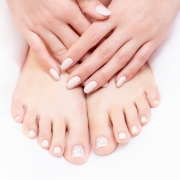Many people suffer from ingrown toenails. According to the Illinois Podiatric Medical Association, “ingrown toenails or other toenail problems” affect about 1 in 20 Americans. Depending on the severity of the situation, ingrown toenails can range from a nuisance to a serious medical concern. Austin podiatrist, Dr. Jeffery LaMour, is committed to helping our patients care for their feet, which includes having healthy toenails. If you realize you’re struggling with an ingrown toenail but can’t immediately get professional treatment, we don’t want you to wait in pain. Fortunately, there are many techniques you can use to alleviate the discomfort caused by this condition. In the following blog, we’ll explain how you can spot the symptoms of an ingrown toenail and the five best remedies for relieving the pain.
What is an Ingrown Toenail?
Simply put, an ingrown toenail is exactly what it sounds like. Ideally, your toenails would grow straight out, covering your nail bed and nothing more. However, sometimes, the toenail can begin to grow into the flesh around the nail bed, which can be quite uncomfortable. For example, if you trim your toenail too short, this “encourages the skin next to the nail to fold over the nail,” as Foot Health Facts explains. Improper nail care is the most prevalent cause, but injury, undersized shoes, and fungal infections can also lead to ingrown toenails. In addition, some people have a hereditary disposition to this condition. If your toenails naturally curve more, you should take especially excellent care of your toenails.
You may be suffering from an ingrown toenail if:
- You notice the toenail beginning to grow over the surrounding skin. You may not be able to see the edges of the nail on one or more sides.
- You feel a sharp sensation as the toenail jabs into the skin.
- The skin around one or more toenails feels particularly sensitive.
- Your skin starts to swell around the toenail.
- The tissue around your toenail is pink or red.
- You notice pus, oozing, or other symptoms of infection in the skin around a toenail.
Recommended Remedies
You may not be able to run out to a podiatrist right away when you notice ingrown toenail symptoms. Dr. LaMour and our team suggest trying the following five methods to relieve pain:
1. Bandage the affected toe. Depending on the size of the toenail, you can do so with a regular adhesive bandage or use sterile gauze. This remedy is simple but important, as it can help keep your sensitive skin clean and shield it against air, heat, and cold, which could worsen the pain.
2. Do a warm salt soak. WikiHow explains: “use a large bowl or your bathtub to soak your foot. This will help reduce swelling and tenderness… Add Epsom salts to the water. Epsom salts are widely recognized for their ability to reduce pain and swelling. These will also help soften the toenail.” If you can’t get Epsom salt, plain old table salt will also do the trick to “help reduce the growth of bacteria.” After you’ve soaked, make sure to dry your foot thoroughly, as moisture can invite bacteria.
3. “Floss” your feet. It may seem a bit odd, but carefully working dental floss between the nail and the damaged skin can help them begin to grow apart and remove bacteria. However, you must be very gentle, as jamming floss into the area could allow further bacteria in, it could hurt, and could generally make matters worse. WikiHow recommends “flossing” the toenail after a salt soak, so “the toenail [is] softened” and somewhat sanitized.
4. Use a topical antibiotic on the area. In her Everyday Health article on treating ingrown toenails, Diana Rodriguez writes: “rub your toe with antibiotic ointment to help reduce your chance of developing an infection.”
5. Wear flexible footwear. As Rodriguez notes: “shoes made of soft fabrics with a wide toe are a good choice – try wearing sandals if you can. Avoid shoes that pinch the toes or place pressure on the ingrown toenail.”
How Dr. LaMour Can Help
While these remedies can help keep you comfortable in the short-term, you shouldn’t wait more than a few days to seek treatment from a podiatrist like Dr. LaMour. Generally, the longer you delay getting professional assistance, the worse your ingrown toenail will become. Dr. LaMour and our team can quickly and easily handle this condition, especially since it is one of the most common issues we address in our practice.
In most cases, we’ll perform a basic outpatient procedure. Dr. LaMour will anesthetize the toe and then remove the abnormal section of the nail. We will then bandage your toe and explain how to care for it so it can heal rapidly. Often, our patients are back to normal the just one day after this treatment. If your ingrown toenail is due to a congenital or structural issue with your feet, we may recommend a different procedure in which we remove the root of the toenail so that it cannot become ingrown again.
Contact Your Austin Podiatrist Today
Are you suffering from an ingrown toenail? Would you like to learn more about our recommended remedies or schedule a treatment? Contact us today! We look forward to hearing from you.






